By Leen Randell
Updated: Jul 10, 2024
10 Best Herbal Decoctions For Upper Abdominal Pain
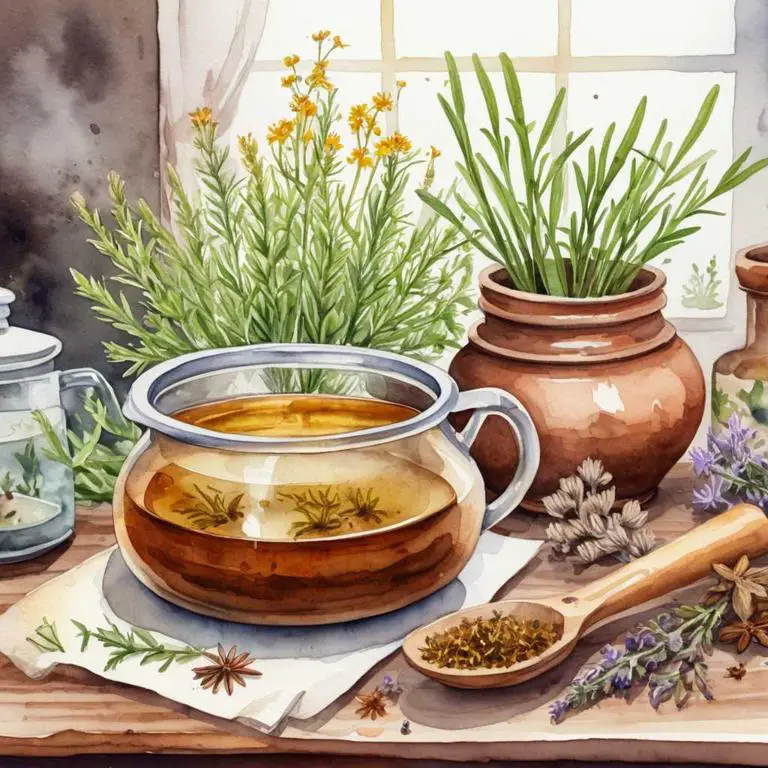
Herbal decoctions for upper abdominal pain are a natural remedy that has been used for centuries to alleviate discomfort, cramping, and burning sensations in the upper abdomen.
These decoctions are made by steeping herbs in hot water, which releases their active compounds that soothe the digestive system and relieve inflammation. Examples of herbal decoctions that help with upper abdominal pain include peppermint tea, ginger decoction, and chamomile infusion.
These decoctions not only ease discomfort but also promote digestion, reduce nausea, and improve overall well-being, allowing individuals to resume their daily activities with renewed energy and confidence.
The following article describes in detail the most important decoctions for upper abdominal pain, including medicinal properties, parts of herbs to use, and recipes for preparations.
- 1. Glycyrrhiza glabra
- 2. Zingiber officinale
- 3. Cinnamomum verum
- 4. Pimpinella anisum
- 5. Matricaria chamomilla
- 6. Foeniculum vulgare
- 7. Sambucus nigra
- 8. Angelica archangelica
- 9. Urtica dioica
- 10. Taraxacum officinale
- What is the best combination of herbal decoctions to use for upper abdominal pain?
- What ailments similar to upper abdominal pain are treated with herbal decoctions?
1. Glycyrrhiza glabra
Licorice decoctions helps with upper abdominal pain because it has natural anti-inflammatory properties that can soothe irritated stomach lining and reduce inflammation in the digestive tract.
The root's bioactive compounds, such as glycyrrhizin and flavonoids, work together to relax smooth muscle contractions, calming cramps and spasms that can cause discomfort in the upper abdomen.
Additionally, licorice decoctions may help regulate digestion and alleviate symptoms of irritable bowel syndrome (IBS), providing relief from persistent pain and discomfort.

Medicinal Constituents
The list below shows the primary medicinal constituents in Glycyrrhiza glabra decoctions that help with upper abdominal pain.
- Glycyrrhizin: As a potent anti-inflammatory and antioxidant, glycyrrhizin helps to reduce inflammation and soothe the gastrointestinal tract, providing relief from upper abdominal pain.
- Liquiritigenin: This flavonoid compound has anti-inflammatory and analgesic properties, which help to alleviate pain and discomfort in the upper abdomen, while also protecting the stomach lining from damage.
- 18α-glycyrrhetinic acid: As a potent inhibitor of prostaglandin synthesis, 18α-glycyrrhetinic acid helps to reduce inflammation and alleviate pain in the upper abdomen by blocking the production of pro-inflammatory mediators.
Parts Used
The list below shows the primary parts of licorice used to make decoctions for upper abdominal pain.
- Roots: Rich in glycyrrhizin, which helps to reduce inflammation and alleviate pain in the upper abdomen.
- Leaves: Contain flavonoids and phenolic acids that contribute to their anti-inflammatory and soothing effects on the upper abdominal area.
- Barks: Have been used in traditional medicine for their anti-inflammatory properties, which can help to alleviate upper abdominal pain.
Quick Recipe
The following recipe gives a procedure to make a basic licorice for upper abdominal pain.
- Harvest fresh or dried roots of the plant with a yield of 1 part to 2 parts of roots.
- Cut the roots into small pieces and clean them thoroughly to remove any dirt or debris.
- Combine 1 teaspoon of the root pieces with 1 cup of boiling water in a heat-resistant container.
- Steep the mixture for 10 to 20 minutes to allow the active compounds to infuse into the water.
- Strain the liquid through a cheesecloth or fine-mesh sieve to remove the solids and discard the solids.
2. Zingiber officinale
Ginger decoctions helps with upper abdominal pain because of its natural anti-inflammatory properties.
The bioactive compounds in ginger, such as gingerol and shogaol, have been shown to reduce inflammation in the digestive tract, which can help alleviate symptoms of upper abdominal pain caused by conditions like irritable bowel syndrome (IBS) or gastritis.
Additionally, ginger's warming and soothing properties can help relax the muscles in the stomach and intestines, providing quick relief from discomfort and cramping.

Medicinal Constituents
The list below shows the primary medicinal constituents in Zingiber officinale decoctions that help with upper abdominal pain.
- Gingerols: These phenolic compounds have anti-inflammatory and analgesic properties, which help to reduce pain and inflammation associated with upper abdominal issues such as nausea and indigestion.
- Shogaols: Similar to gingerols, shogaols are also phenolic compounds that exhibit anti-inflammatory and analgesic effects, which contribute to the relief of upper abdominal pain and discomfort.
- 6-gingerol: This specific gingerol has been shown to have a direct effect on the gastrointestinal tract, reducing inflammation and improving gut motility, which can help alleviate upper abdominal pain and discomfort.
Parts Used
The list below shows the primary parts of ginger used to make decoctions for upper abdominal pain.
- Rhyzomes: These are the most commonly used part for upper abdominal pain due to their high concentration of active compounds like gingerols and shogaols, which have anti-inflammatory properties.
- Stems: Some traditional medicine practices use the stems of Zingiber officinale, as they are believed to contain some of the same active compounds as the rhyzomes, providing similar pain-relieving effects.
- Leaves: The leaves of Zingiber officinale are also used in some decoctions, as they are thought to contain smaller amounts of the active compounds found in the rhyzomes and stems, still providing some pain-relieving benefits.
Quick Recipe
The following recipe gives a procedure to make a basic ginger for upper abdominal pain.
- Gather 1-2 teaspoons of dried zingiber officinale rhizome and clean it thoroughly.
- Boil 1 cup of water and reduce the heat to a simmer.
- Add the dried zingiber officinale rhizome to the boiling water and steep for 5-10 minutes.
- Strain the decoction through a fine-mesh sieve into a clean container and discard the solids.
- Store the decoction in the refrigerator for up to 24 hours before consumption.
3. Cinnamomum verum
Ceylon cinnamon decoctions helps with upper abdominal pain because it has a soothing effect on the digestive system.
The anti-inflammatory properties of its active compounds, such as cinnamaldehyde and epicatechin, help to reduce inflammation in the stomach and intestines, alleviating discomfort and cramping associated with conditions like IBS and gastritis.
Additionally, Ceylon cinnamon's warming properties can help to stimulate digestion and relieve bloating, providing relief from upper abdominal pain and discomfort.
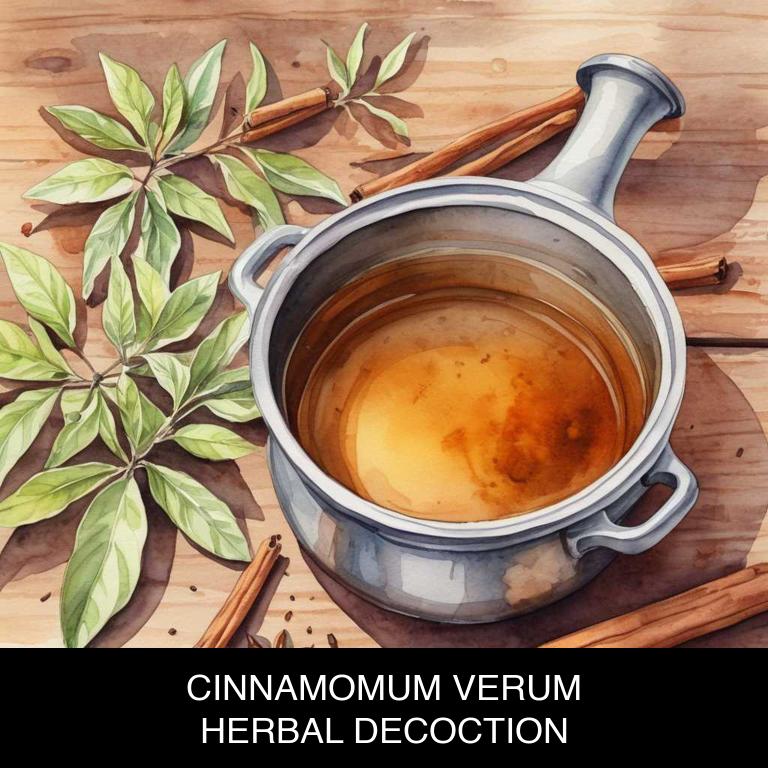
Medicinal Constituents
The list below shows the primary medicinal constituents in Cinnamomum verum decoctions that help with upper abdominal pain.
- Cinnamaldehyde: This phenolic compound has anti-inflammatory and antispasmodic properties, which help to relax the muscles in the upper abdominal region and reduce pain.
- Eugenol: This phenolic compound has analgesic and anti-inflammatory properties, which help to reduce pain and inflammation in the upper abdominal region, providing relief from conditions such as gastritis and ulcers.
- Cinnamomin: This terpene has antispasmodic and anti-inflammatory properties, which help to relax the muscles in the upper abdominal region and reduce pain, also exhibiting antimicrobial properties to prevent infections.
Parts Used
The list below shows the primary parts of ceylon cinnamon used to make decoctions for upper abdominal pain.
- Rhyzomes: They are commonly used due to their warm, spicy, and carminative properties, which help to soothe and calm the digestive system.
- Barks: The barks are used due to their ability to warm the digestive system and reduce inflammation, providing relief from upper abdominal pain.
- Leaves: The leaves are used due to their ability to reduce inflammation and promote digestion, helping to alleviate upper abdominal pain and discomfort.
Quick Recipe
The following recipe gives a procedure to make a basic ceylon cinnamon for upper abdominal pain.
- Harvest 20-30 grams of cinnamomum verum bark from mature trees, cutting them into small pieces.
- Dry the cinnamomum verum pieces in a single layer at room temperature for 2-3 weeks.
- Grind the dried cinnamomum verum pieces into a fine powder using a mortar and pestle.
- Steep 1-2 teaspoons of the ground cinnamomum verum powder in 250 milliliters of boiling water for 10-15 minutes.
- Strain the decoction through a cheesecloth or fine-mesh sieve into a clean container, discarding the solids.
4. Pimpinella anisum
Anise decoctions helps with upper abdominal pain because of its ability to soothe the digestive system.
The essential oils present in anise, such as anethole, have a calming effect on the stomach lining, reducing inflammation and spasms that can cause discomfort. Additionally, anise has natural carminative properties, which help to ease gas and bloating, further alleviating upper abdominal pain.
This makes anise decoctions a popular herbal remedy for individuals experiencing cramps, nausea, and digestive issues in this area.
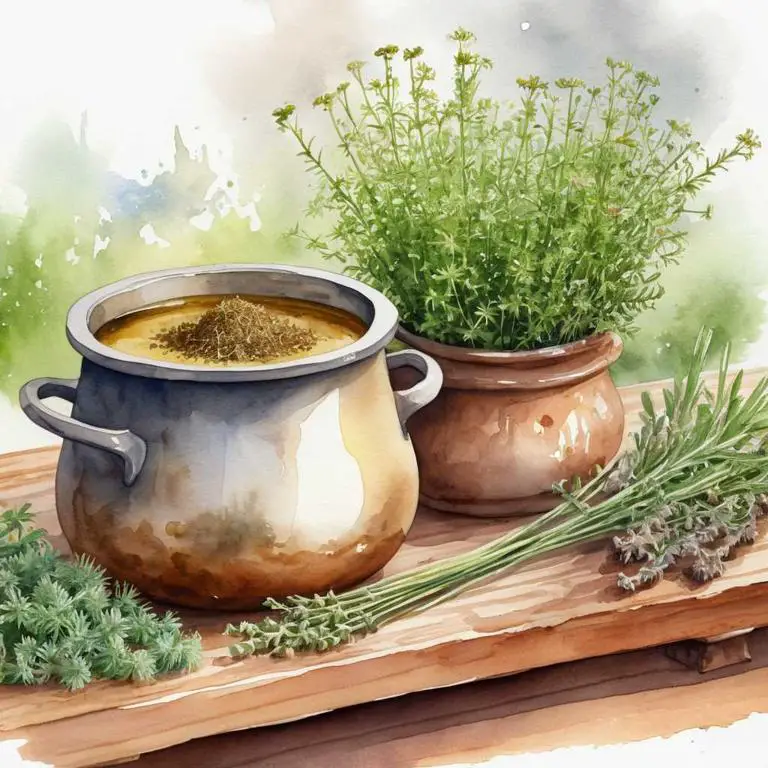
Medicinal Constituents
The list below shows the primary medicinal constituents in Pimpinella anisum decoctions that help with upper abdominal pain.
- Anethole: Anethole is a terpene found in Pimpinella anisum decoctions. It helps with upper abdominal pain by relaxing the smooth muscle in the gastrointestinal tract, reducing spasms and cramping.
- Anisic acid: Anisic acid is a phenolic compound found in Pimpinella anisum decoctions. It helps with upper abdominal pain by reducing inflammation and modulating the gut's natural defenses, which can contribute to pain and discomfort.
- Ligustilide: Ligustilide is a sesquiterpene found in Pimpinella anisum decoctions. It helps with upper abdominal pain by exhibiting anti-inflammatory and antispasmodic properties, which can help alleviate pain and discomfort.
Parts Used
The list below shows the primary parts of anise used to make decoctions for upper abdominal pain.
- Seeds: They are used due to their carminative and antispasmodic properties, which help to ease abdominal cramps and pain.
- Leaves: They are used due to their antispasmodic and anti-inflammatory properties, which help to relax the muscles and reduce inflammation in the upper abdominal region.
- Fruits: They are used due to their carminative and anti-inflammatory properties, which help to ease digestion and reduce pain in the upper abdominal area.
Quick Recipe
The following recipe gives a procedure to make a basic anise for upper abdominal pain.
- Harvest fresh anise seeds from mature plants to ensure optimal flavor and aroma.
- Clean and dry anise seeds in a low-temperature oven at 150 degrees fahrenheit for 2 hours.
- Measure 2 teaspoons of dried anise seeds and add them to 1 quart of boiling water.
- Steep the mixture for 10 to 15 minutes to allow the seeds to infuse their flavor.
- Strain the decoction and discard the solids to produce a clear herbal liquid.
5. Matricaria chamomilla
Chamomile decoctions helps with upper abdominal pain because of its anti-inflammatory and soothing properties.
The apigenin content in chamomile binds to GABA receptors, calming the digestive system and reducing spasms that can cause discomfort. Additionally, chamomile's antioxidant effects help reduce inflammation and irritation in the gut, which can contribute to abdominal pain.
By promoting relaxation and reducing inflammation, chamomile decoctions provide natural relief from upper abdominal pain, making it a popular remedy for individuals seeking alternative therapy for digestive issues.

Medicinal Constituents
The list below shows the primary medicinal constituents in Matricaria chamomilla decoctions that help with upper abdominal pain.
- Apigenin: This flavonoid acts as a potent anti-inflammatory and spasmolytic agent, helping to relieve muscle spasms and inflammation in the upper abdominal region.
- Luteolin: As an anti-inflammatory and antioxidant compound, luteolin helps to reduce inflammation and alleviate pain associated with upper abdominal discomfort.
- Α-bisabolol: This sesquiterpene has anti-inflammatory, spasmolytic, and soothing properties, which can help to calm digestive issues, reduce spasms, and provide relief from upper abdominal pain.
Parts Used
The list below shows the primary parts of chamomile used to make decoctions for upper abdominal pain.
- Flowers: They are used to make decoctions for upper abdominal pain due to their anti-inflammatory and soothing properties.
- Seeds: They contain apigenin, a compound that has been shown to have a relaxing effect on the digestive system, helping to alleviate upper abdominal pain.
- Leaves: The leaves of Matricaria chamomilla are used in decoctions to help soothe digestive issues and reduce inflammation in the upper abdominal region.
Quick Recipe
The following recipe gives a procedure to make a basic chamomile for upper abdominal pain.
- Measure out 1 to 2 teaspoons of dried matricaria chamomilla flowers for every 8 ounces of water.
- Combine the measured flowers with 8 ounces of water in a saucepan and bring to a boil.
- Reduce heat and let the decoction simmer for 5 to 10 minutes or until the liquid has reduced slightly.
- Strain the decoction through a cheesecloth or a fine-mesh sieve into a clean container to remove the solids.
- Allow the decoction to cool before transferring it to an airtight container for storage.
6. Foeniculum vulgare
Fennel decoctions helps with upper abdominal pain because its active compounds, such as anethole and fenchol, have natural anti-inflammatory and digestive properties.
These compounds help to relax the muscles in the stomach and intestines, reducing spasms and cramps that can cause discomfort and pain. Additionally, fennel's carminative effects help to alleviate bloating and gas, which can contribute to upper abdominal pain.
By soothing the digestive tract and alleviating symptoms, fennel decoctions provide natural relief from upper abdominal pain.
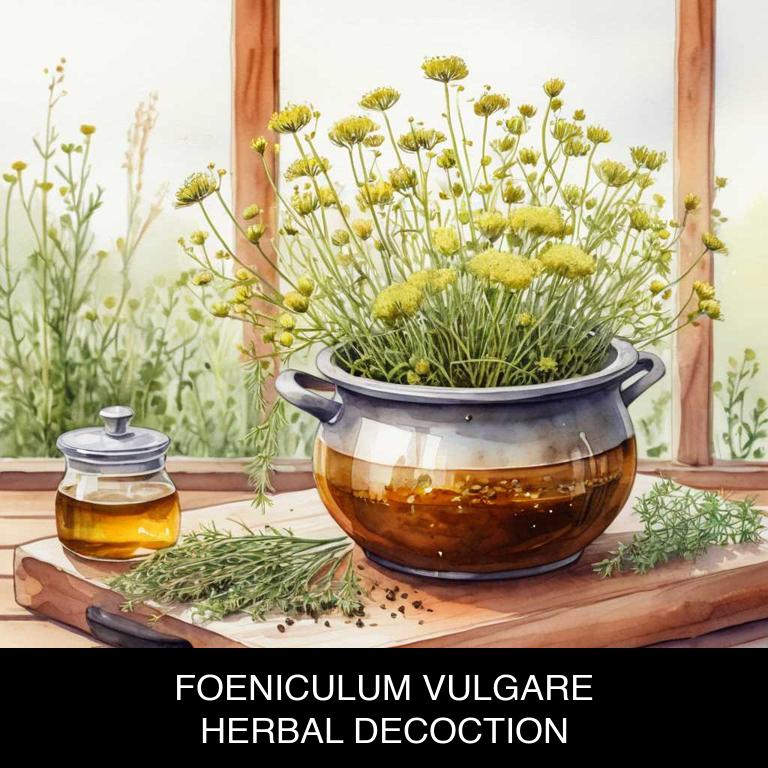
Medicinal Constituents
The list below shows the primary medicinal constituents in Foeniculum vulgare decoctions that help with upper abdominal pain.
- Anethole: A phenolic compound that has anti-inflammatory and antispasmodic properties, helping to relax the muscles in the upper abdomen and reduce pain.
- Foeniculin: A sesquiterpene that has anti-inflammatory and spasmolytic effects, which can help to reduce inflammation and alleviate cramping in the upper abdominal region.
- Diacetyl: A terpene that has antispasmodic and anti-inflammatory properties, helping to calm muscle spasms and reduce pain in the upper abdomen.
Parts Used
The list below shows the primary parts of fennel used to make decoctions for upper abdominal pain.
- Seeds: They are used due to their carminative properties, which help to relieve gas and reduce discomfort in the upper abdomen.
- Leaves: They are used due to their antispasmodic properties, which help to relax the muscles in the digestive tract and alleviate upper abdominal pain.
- Roots: They are used due to their anti-inflammatory properties, which help to reduce inflammation and alleviate pain in the upper abdomen.
Quick Recipe
The following recipe gives a procedure to make a basic fennel for upper abdominal pain.
- Harvest 20-30 fresh foeniculum vulgare stems with leaves and flowers for decoction preparation.
- Rinse the foeniculum vulgare stems in cold running water to remove dirt and debris instantly.
- Chop the foeniculum vulgare stems into smaller pieces to increase surface area for decoction.
- Combine 1 tablespoon of chopped foeniculum vulgare with 1 cup of boiling water for decoction.
- Simmer the decoction for 5-7 minutes or until the liquid reduces slightly and flavor intensifies.
7. Sambucus nigra
Elder decoctions helps with upper abdominal pain because of its potent anti-inflammatory and antispasmodic properties.
The decoction's bioactive compounds, such as flavonoids and phenolic acids, help to reduce inflammation and relax the smooth muscle in the digestive tract, providing relief from cramping and discomfort. Additionally, elder's antimicrobial properties may also help to combat underlying infections that can contribute to upper abdominal pain.
By soothing and calming the digestive system, elder decoctions offer a natural and effective way to alleviate upper abdominal pain.
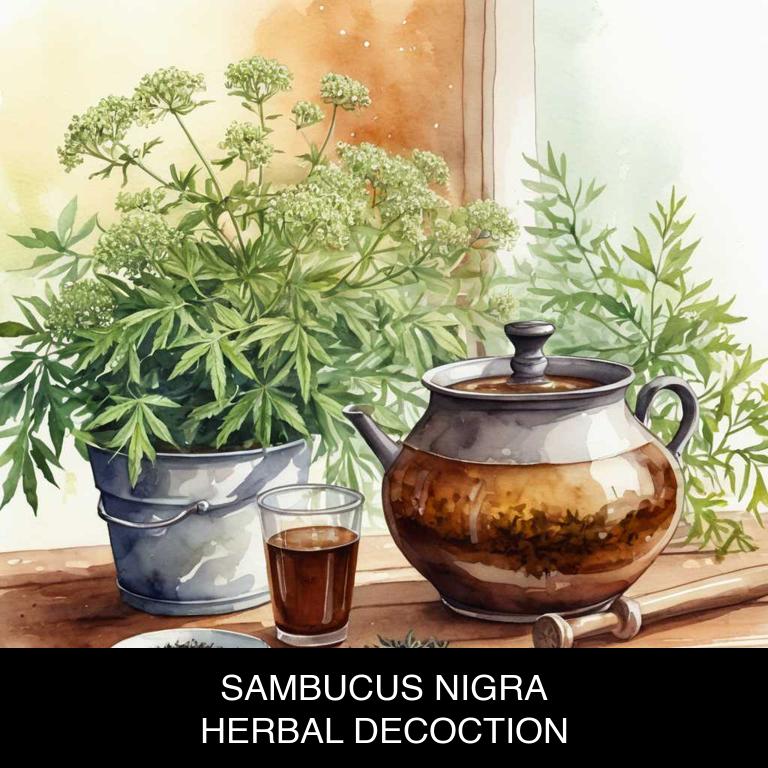
Medicinal Constituents
The list below shows the primary medicinal constituents in Sambucus nigra decoctions that help with upper abdominal pain.
- Flavonoids: These plant-derived compounds help alleviate upper abdominal pain by reducing inflammation and modulating the gut-brain axis, thereby relieving discomfort and pain associated with conditions such as gastritis and irritable bowel syndrome (IBS).
- Phenolic acids: These acidic compounds exhibit anti-inflammatory and antioxidant properties, which help to soothe the digestive tract and alleviate upper abdominal pain by reducing inflammation and oxidative stress in the stomach and intestines.
- Ellagic acid: A polyphenolic compound with potent antioxidant and anti-inflammatory properties, ellagic acid helps to protect the stomach lining from damage and reduce inflammation, thereby alleviating upper abdominal pain and discomfort associated with conditions such as gastritis and peptic ulcers.
Parts Used
The list below shows the primary parts of elder used to make decoctions for upper abdominal pain.
- Flowers: They are used due to their antispasmodic properties, which help to relax the muscles in the upper abdominal area and reduce pain.
- Leaves: They are used due to their anti-inflammatory properties, which help to reduce inflammation and discomfort in the upper abdominal area.
- Fruits: They are used due to their laxative properties, which help to promote digestion and relieve constipation, a common cause of upper abdominal pain.
Quick Recipe
The following recipe gives a procedure to make a basic elder for upper abdominal pain.
- Collect fresh sambucus nigra flowers and leaves from a trusted source or grow them in a controlled environment.
- Measure 2-4 grams of the collected sambucus nigra flowers and leaves per 250 milliliters of water.
- Combine the measured sambucus nigra flowers and leaves with the water in a pot or teapot.
- Heat the mixture over low heat for 10-15 minutes or until the liquid reaches a temperature of 70-80 degrees celsius.
- Strain the decoction through a cheesecloth or a fine-mesh sieve to remove the solids and discard the solids.
8. Angelica archangelica
Angelica decoctions helps with upper abdominal pain because of its unique combination of bioactive compounds, particularly furanocoumarins and sesquiterpenes.
These compounds have been shown to exhibit anti-inflammatory and spasmolytic properties, which can effectively alleviate muscle cramps and spasms in the abdominal muscles, thereby reducing pain and discomfort in the upper abdominal region.
Additionally, angelica's carminative properties may help to relieve gas and bloating, further contributing to its therapeutic effects on upper abdominal pain.
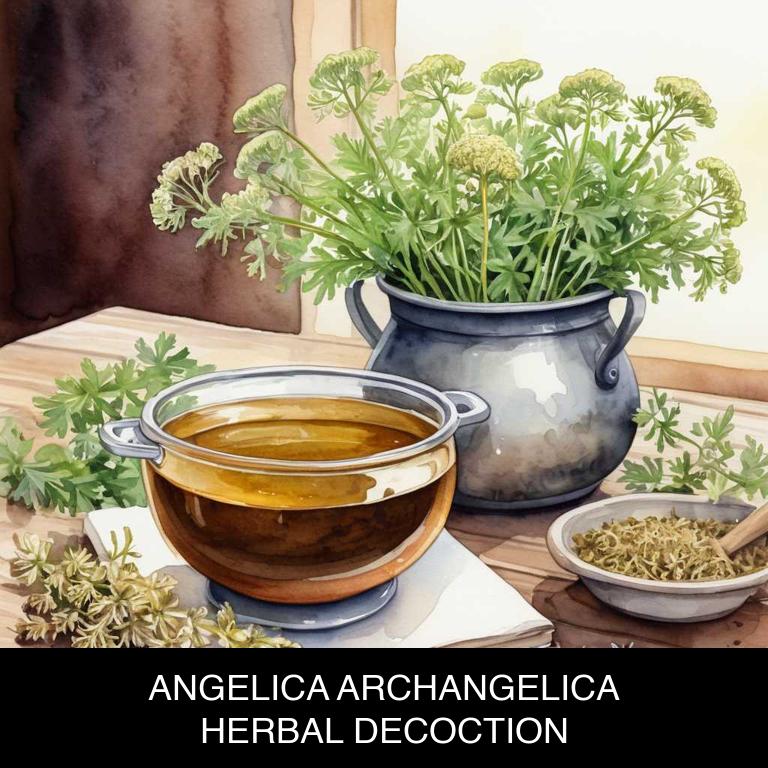
Medicinal Constituents
The list below shows the primary medicinal constituents in Angelica archangelica decoctions that help with upper abdominal pain.
- Angelol: A phenolic compound found in Angelica archangelica, angelol has anti-inflammatory and antioxidant properties, which help reduce inflammation and soothe digestive issues that cause upper abdominal pain.
- Angelica acid: A phenolic compound, angelica acid has anti-inflammatory and carminative properties, which help ease digestive discomfort, reduce inflammation, and alleviate upper abdominal pain.
- Phenolic glycosides: These compounds have anti-inflammatory and antioxidant properties, which help reduce inflammation, soothe digestive issues, and alleviate upper abdominal pain caused by digestive disorders.
Parts Used
The list below shows the primary parts of angelica used to make decoctions for upper abdominal pain.
- Roots: The roots are used due to their high concentration of bioactive compounds, such as flavonoids and phenolic acids, which have anti-inflammatory and spasmolytic properties.
- Leaves: The leaves are used for their mild digestive and anti-inflammatory effects, which help soothe and calm the upper abdominal region.
- Stems: The stems are used due to their rich content of volatile oils, which have anti-inflammatory and carminative properties, helping to ease abdominal discomfort and reduce gas.
Quick Recipe
The following recipe gives a procedure to make a basic angelica for upper abdominal pain.
- Harvest fresh angelica archangelica roots and rhizomes in the autumn when they are mature and dry.
- Wash the harvested roots and rhizomes with cold running water to remove dirt and debris.
- Chop the cleaned roots and rhizomes into small pieces weighing approximately 20-30 grams for every 250 milliliters of water.
- Combine the chopped roots and rhizomes with 250 milliliters of boiling water in a saucepan and let steep for 10-15 minutes.
- Strain the decoction through a cheesecloth or a fine-mesh sieve into a clean container discarding the solids.
9. Urtica dioica
Stinging nettle decoctions helps with upper abdominal pain because of its natural anti-inflammatory properties.
The decoction's flavonoids and saponins work to reduce inflammation in the digestive tract, soothing the stomach lining and relaxing the muscles that can become tense and spasmodic. This calming effect helps to alleviate symptoms such as bloating, cramps, and discomfort associated with conditions like IBS and gastritis.
Additionally, nettle's ability to relax the gut can also improve digestion and reduce feelings of fullness and nausea.

Medicinal Constituents
The list below shows the primary medicinal constituents in Urtica dioica decoctions that help with upper abdominal pain.
- Flavonoids: These help with upper abdominal pain by reducing inflammation and modulating the body's pain response, thereby providing relief from discomfort.
- Phenolic acids: These compounds help alleviate upper abdominal pain by exhibiting antioxidant and anti-inflammatory properties, which help to soothe and protect the gastrointestinal tract.
- Sterols: These help with upper abdominal pain by reducing inflammation and improving gut motility, which can help to alleviate digestive discomfort and promote the healing of the gastrointestinal tract.
Parts Used
The list below shows the primary parts of stinging nettle used to make decoctions for upper abdominal pain.
- Leaves: They are rich in anti-inflammatory compounds and flavonoids, which help to reduce pain and inflammation in the digestive tract.
- Roots: They contain a high concentration of isoorientin, a flavonoid with anti-inflammatory and antispasmodic properties, which can help to relieve abdominal cramps and pain.
- Stems: They contain a mixture of flavonoids and carotenoids, which have anti-inflammatory and antioxidant effects, helping to soothe and calm the digestive tract.
Quick Recipe
The following recipe gives a procedure to make a basic stinging nettle for upper abdominal pain.
- Harvest 1-2 bunches of fresh urtica dioica leaves and stems in the spring or early summer when in full growth.
- Clean the harvested urtica dioica thoroughly with water to remove any dirt or debris.
- Chop 2-3 tablespoons of the cleaned urtica dioica into small pieces and place in a saucepan.
- Combine the chopped urtica dioica with 2 cups of water in the saucepan and bring to a boil.
- Simmer the mixture for 5-7 minutes or until reduced to about half the original volume.
10. Taraxacum officinale
Dandelion decoctions helps with upper abdominal pain because it has anti-inflammatory properties that help to soothe and calm irritated digestive tissues.
The bitter compounds in dandelion root stimulate digestion, reducing bloating and cramping associated with irritable bowel syndrome (IBS) and other gastrointestinal issues.
Additionally, dandelion's natural antispasmodic effects can help to ease muscle contractions and relax the abdominal muscles, providing relief from discomfort and pain in the upper abdomen.

Medicinal Constituents
The list below shows the primary medicinal constituents in Taraxacum officinale decoctions that help with upper abdominal pain.
- Taraxasterol: This triterpenoid saponin helps with upper abdominal pain by reducing inflammation and relaxing the smooth muscles in the digestive tract.
- Luteolin: This flavonoid phenolic compound helps with upper abdominal pain by reducing inflammation, inhibiting the release of pain-causing chemicals, and exerting a protective effect on the stomach lining.
- Inulin: This fructan polysaccharide helps with upper abdominal pain by regulating gut bacteria, improving digestion, and reducing symptoms of irritable bowel syndrome (IBS).
Parts Used
The list below shows the primary parts of dandelion used to make decoctions for upper abdominal pain.
- Leaves: The leaves of Taraxacum officinale are used due to their high content of flavonoids and saponins, which help reduce inflammation and alleviate pain.
- Roots: The roots are used because they contain inulin, a prebiotic fiber that helps regulate gut bacteria, reducing inflammation and alleviating upper abdominal pain.
- Seeds: The seeds are used due to their high content of sesquiterpenes and flavonoids, which have anti-inflammatory and antioxidant properties that help soothe upper abdominal pain.
Quick Recipe
The following recipe gives a procedure to make a basic dandelion for upper abdominal pain.
- Harvest taraxacum officinale flowers and leaves from a clean area at dawn when dew is still present.
- Dry the taraxacum officinale flowers and leaves in a single layer at 60 degrees celsius for two hours.
- Combine one teaspoon of dried taraxacum officinale flowers and leaves with 250 milliliters of boiling water in a pot.
- Steep the mixture for 10 to 15 minutes then strain it to create a decoction.
- Cool the decoction to room temperature before storing it in a dark glass container for later use.
What is the best combination of herbal decoctions to use for upper abdominal pain?
The best combination of herbal decoctions that help with upper abdominal pain is a blend of Dandelion root (Taraxacum officinale), Peppermint leaf (Mentha piperita), and Ginger root (Zingiber officinale).
Dandelion root aids in liver and kidney function, Peppermint leaf soothes digestive issues, and Ginger root reduces inflammation and nausea.
This synergy of herbs can help alleviate discomfort, promote digestion, and support overall gut health, providing relief from upper abdominal pain and promoting a sense of well-being.
What ailments similar to upper abdominal pain are treated with herbal decoctions?
Ailments similar to upper abdominal pain that are treated with herbal decoctions are digestive disorders such as bloating, indigestion, and constipation.
Herbal remedies like peppermint, ginger, and chamomile have anti-inflammatory properties that help soothe the stomach and alleviate symptoms of irritable bowel syndrome (IBS), acid reflux, and dyspepsia.
Additionally, herbal decoctions may be used to treat gallbladder issues, such as cholecystitis and gallstones, by reducing inflammation and promoting digestion.